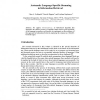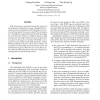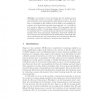100
Voted
FGR
1996
IEEE
15 years 4 months ago
1996
IEEE
We demonstrate a system capable of tracking, in real world image sequences, landmarks such as eyes, mouth, or chin on a face. In the standard version, knowledge previously collect...
92
Voted
ICRA
1999
IEEE
15 years 5 months ago
1999
IEEE
Currently, the viability of infrared IR as an accurate means of measuring distance depends on extensive prior knowledge of the surface. More speci cally, the manner in which a sur...
77
Voted
CLEF
2000
Springer
15 years 5 months ago
2000
Springer
We employ Automorphology, an MDL-based algorithm that determines the suffixes present in a language-sample with no prior knowledge of the language in question, and describe our exp...
WECWIS
2000
IEEE
15 years 5 months ago
2000
IEEE
XML documents are semistructured and the structure of the documents is embedded in the tags. Although XML documents can be accompaniedby a DTD that defines the structure of the d...
64
Voted
IJCNN
2000
IEEE
15 years 5 months ago
2000
IEEE
KBCC is an extension of the cascade-correlation algorithm that treats functions encapsulating prior knowledge as black-boxes which, like simple sigmoidal neurons, can be recruited...
95
Voted
IFSA
2003
Springer
15 years 6 months ago
2003
Springer
In fuzzy modeling (FM), the quantity and quality of the training set is crucial to properly grasp the behavior of the system being modeled. However, the available data are often n...
108
click to vote
KDD
2004
ACM
15 years 6 months ago
2004
ACM
Like many purely data-driven machine learning methods, Support Vector Machine (SVM) classifiers are learned exclusively from the evidence presented in the training dataset; thus ...
107
Voted
GCC
2005
Springer
15 years 6 months ago
2005
Springer
Combination of prior knowledge and implicit knowledge hidden in the data of system can enhance the quality of information services in Knowledge Grid. Fuzzy Cognitive Maps (FCMs) ar...
83
Voted
ECML
2005
Springer
15 years 6 months ago
2005
Springer
Incorporation of prior knowledge into the learning process can significantly improve low-sample classification accuracy. We show how to introduce prior knowledge into linear supp...
SIGMOD
2005
ACM
15 years 6 months ago
2005
ACM
Decision makers of companies often face the dilemma of whether to release data for knowledge discovery, vis a vis the risk of disclosing proprietary or sensitive information. Whil...



